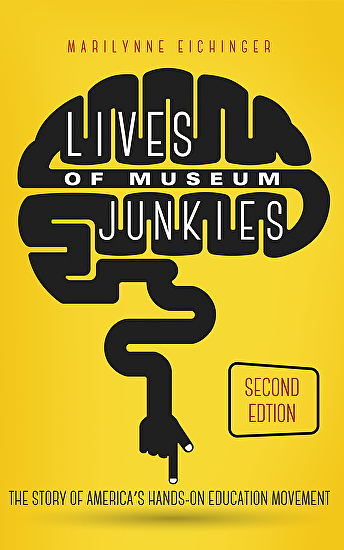
Revised and re-edited, the second edition of Lives of Museum Junkies is now available. It corrects mistakes and brings stories about the development of science centers up to date, covering ongoing events affecting communities nationwide.
* * *
When I was a young wife and mother, I started a science museum in my basement. It was 1972 when Impression 5 Science Museum was incorporated as a non-for-profit organization in Lansing, Michigan. That action heralded the beginning of an adventure that changed a timid, naive woman into one capable of running the Oregon Museum of Science and Industry (OMSI), one of the nation’s foremost science museums.
A wise man advised me, “When the time feels right, go for it! Don’t wait for everyone else to agree with your dreams because that never happens. Grab your own opportunities.” And that is what I did, though not alone. In Lives of Museum Junkies: Second Edition I share the joys and difficulties I experienced, as well as the struggles of eleven men and women who were on the leading edge of an international movement to create experiential museums dedicated to science.
As pioneers, we were change agents influencing the country’s education ethos. And, as visionaries, we broke from tradition by combining art with science, engineering, math, and technology. Years later schools followed our leadership with a curriculums known as STEM, and when the arts got included, STEAM education. We saw ourselves as promoters of lifelong self-improvement, practitioners of creative problem-solving, believers in equal opportunity, disseminators of the latest scientific information, and teachers who made learning so much fun that students were compelled to ask the next question. We wanted visitors to leave the museum yearning to know more.
We were unsophisticated when we started our museums and not skilled at fundraising, board development or staff management. We were artless in the way we constructed interactive displays and did not understand how chauvinism, race, poverty, and social class played a role in what we were doing. Included are sections called “lessons learned” so you will understand how the people I write about were changed by their experiences. Hopefully, the insights shared in the book will be helpful to anyone attempting a new venture.
I built and ran science museums for twenty-five years. In my late fifties, I took a risk by leaving the comfortable cocoon I had spun around me. With the help of twenty-two national museums and several board members, I left OMSI to found the Museum Tour Catalog in order to spread science literacy to homes throughout the country. My goal was to provide parents with information and hands-on manipulative devices in order to help their children become engaged in doing and questioning rather than retreating to mindless television programs.
For eighteen years, The Museum Tour Catalog along with science centers inspired toy companies to develop hands-on science materials for children. Today science and art kits are found everywhere toys are sold. In the pandemic these materials are providing vital props for parents willing to augment virtual classroom learning.
The American Alliance of Museums recently estimated that one-third of the nation’s museums and science centers will close as a result of COVID-19. Thankfully, Impression 5 and OMSI look like they will survive. Their staffs are engaged in educating sequestered children and providing special in-museum offerings for those needing help with homework. They offer a variety of programs for adults craving intellectual stimulation. Special exhibits like the one OMSI opened about Genghis Khan are made available through timed entrance reservations.
What these overworked staff members do is not easy. OMSI, for example, had to reduce its budget by half which meant laying off fifty-three percent of its employees. Though the organization remains viable due to the commitment and inventiveness of its staff and financial support from the community, each day is a struggle.
The revised edition of Lives of Museum Junkies explains how science museums became integrated into their communities, making them valuable assets that help people stay abreast of change. The pandemic focused attention on the importance of heeding scientists and medical professionals with years of training rather than giving credence to wishful thinkers and rumor mongers who extend Covid’s dangerous reaches. Science centers play a critical role in separating truth from fiction in confused minds.
Lives as Museum Junkies’ second edition demonstrates how entrepreneurs who follow their dreams stay motivated and dedicated despite setbacks. Remaining positive and reaching for a better tomorrow is as important today as it was fifty years ago. As Norman Stiles implied in his children’s book Everything in the Whole Wide World Museum, the entire universe is everyone’s museum and we just have to fine tune the way we see things to take advantage of all that is there. I hope my writings will encourage readers to do just that.
Lives of Museum Junkies: Second Edition is available online in ebook and paperback formats. The print version will be in bookstores on Monday, November 2nd.
